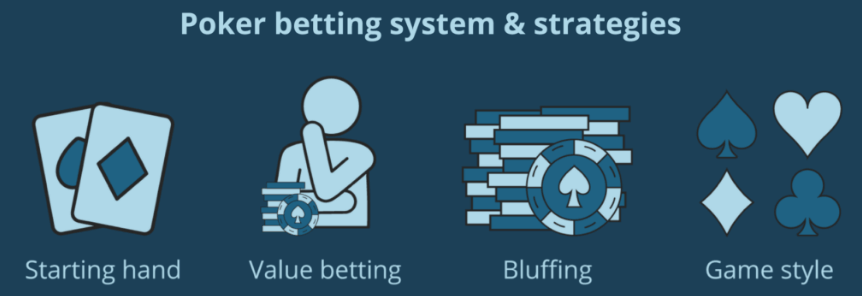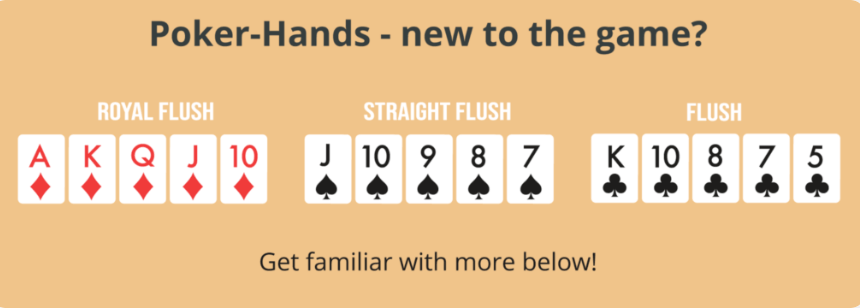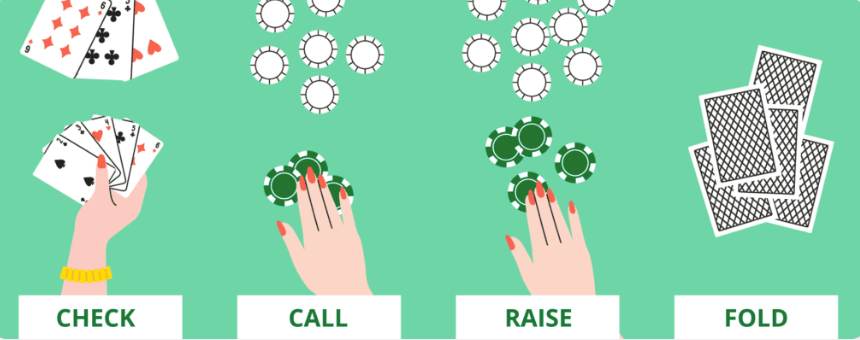Poker Rules, Bets, and Odds
Learn the basics of the most popular card game!Although it’s easy to learn, mastering poker is challenging. Luckily, you can be one step closer to doing this by learning the rules, bets, and odds. Our guide will take you through the essential aspects of how to play poker to increase your knowledge.
Breakdown Of A Poker Round
Even though poker can be a highly complex game, poker rounds always follow the same format.
Every Texas Hold’Em poker round has four phases: blinds, dealing, betting, and payouts. And each phase is characterized by different players’ or dealers’ actions.
Find out the rules of poker

Texas Hold’Em Poker rules are what everyone knows as the basic poker rules. To play poker, you must first understand the rules of the game. Take your time to read through the poker game rules and familiarize yourself with the game’s terms.
| LEARN POKER RULES |
Add money to your balance
You’ll first need to fund your online casino account to play poker. Make sure to deposit an amount suitable to your playing style and budget. Look through your preferred casino‘s supported payment method selection and pick your favorite.
Blinds and minimum bet
Before a poker round can start, players with small and big blind buttons place their bets. Blinds are a type of forced bet placed by the two players following the player with the dealer button. The small big is half the minimum bet, while the big small equals the minimum bet.
The dealer deals the hole cards
Hole cards are the two cards dealt to each player at the start of a poker round. Once the round begins, the dealer hands each player two cards face down. Hole cards are used with the cards facing up to create a hand.
Players make their decision pre-flop
Before the dealer deals the first three cards, a betting round ensues. Players can make four major decisions:
- Bet – Match the big blind.
- Raise – Increase the stake over the big blind.
- All in – Bet their entire bankroll.
- Fold – Quit the round.
Keep in mind that when participating in poker, never do so with money you are not willing to lose. Bankroll management is key to success and the only way to guarantee an enjoyable gaming experience.
| LEARN ABOUT POKER BETS |
The flop is the first three cards
After placing the bets, the dealer burns a card and deals three cards to the table – the flop. Players must use these first three of the five community cards with their hole cards to build a five-card hand.
Post-flop betting
After the flop, a betting round occurs, starting from the player on the left of the dealer button (the small blind). Any player can check in this phase, assuming no bets were placed.
The turn is the fourth card
In this round, the dealer burns a card and deals another card face up on the table, which is called the turn.
Post-turn betting
After the turn, a new round of betting starts. Players bet in the same order as the flop, starting from the small blind.
The river is the fifth card
The dealer burns a card and deals the last card – the river. Players must use their hole cards combined with three of the five community cards to create a hand.
The final betting round
After the last card is dealt, players can place their bets before their hands are compared. If two players remain and one folds during this phase, the winning player can choose whether or not he wants to show his hole cards.
Wins are paid
The last remaining player takes the whole pot. If two or more players remain, the best hand is the winner. If there’s a tie, the players’ highest card – the kicker, will be considered. If both players have the same kicker, the pot is evenly split.
Players can predict the change or obtain a specific combination of cards by calculating the poker pot odds. Alternatively, you can find a poker odds chart or use a poker odds calculator to make your decision easier.
| LEARN ABOUT POKER ODDS AND PAYOUTS |
Rules of Poker
Fortunately, the rules of poker are easy to understand. This section will approach everything you need to know about poker rules, including hand rankings, buttons, pot limits, and other essential terms.
The goal of poker
Poker has a straightforward goal – to win the pot. You can achieve this in three main ways: having the best hand, making bets that no player calls, or bluffing your way through.
Hand rankings

There are ten different hands in poker, each with a different ranking. By having a better hand, players have a higher chance of winning.
| Name | Cards Used | Odds |
|---|---|---|
| High Card | The highest card in your hand | 649,739:1 |
| Pair | Two of the same card | 72,192:1 |
| Two pair | Two pairs of the same card | 4,164:1 |
| Three of a Kind | Three of the same card | 693:1 |
| Straight | Five cards that all go up in order | 508:1 |
| Flush | Five of the same suit | 254:1 |
| Full House | Three of a kind and a pair | 46.3:1 |
| Four of a Kind | Four of the same cards | 20:1 |
| Straight Flush | Five cards going up in order, all of the same suit | 1.37:1 |
| Royal Flush | Ace, King, Queen, Jack, and a 10, all of the same suit | 0.995:1 |
Turn, flop, and river
There are three main phases where cards are placed on the table – the turn, flop, and river. The dealer burns a card before each phase. See how each game phase differs:
- Turn – Three cards are dealt to the table.
- Flop – The fourth card is dealt.
- River – The fifth and final card is dealt.
Dealer button
The dealer button is used to identify the dealer. It’s rotated clockwise every time a new hand is shuffled. The two following positions after the dealer are the small and big blinds.
Big and small blinds
These are two forced bets placed by the first two players after the dealer button. The small is equal to half the minimum poker stake, while the big blind is the same value as the minimum bet.
No limit, pot limit, and fixed limit
Poker games can differ in terms of the pot. Pot limits help dictate what bets players may or not place. See how each pot type is different:
- No limit – This type of pot has no maximum bet. Bets are only limited by the players’ stacks.
- Pot Limit – A type of poker game where the size of the pot limits bets and raises.
- Fixed limit – The maximum bets are predetermined before the game begins.
Poker terms you should know
Knowing the different poker terms is an excellent way to improve your knowledge about the poker rules in NJ. Check out our casino dictionary for more poker terms.
| Term | Explanation |
|---|---|
| Hole Cards | The two cards given to each player. |
| Flop | The first three cards dealt to the table. |
| Turn | The fourth card. |
| River | The fifth and final card. |
| Blind | A forced bet placed by two players every round. |
| Check | An action where players can pass on betting. |
| Draw | Staying in a round for a chance to improve your hand. |
| Fold | Giving up your hand. |
| Hand | A combination of five cards made from the hole cards and community cards. |
| Kicker | A high card is used to determine who wins or loses. In the case of a tie, the player with the highest card wins. |
| Stack | The total amount of chips a player has. |
Rules in other poker variants
As one of the most popular card games of all time, poker has multiple variations with different rules and gameplay mechanics. Caribbean Stud, Ultimate Texas Hold’Em, and Omaha are the most popular poker versions. Check out some of their rule variants:
- Omaha – In this variant, players receive four cards instead of two. However, they can only select two to create a hand.
- Caribbean Stud – Players go against the dealer in this variant and must pay an ante to enter the round.
Additionally, poker can have side bets – secondary bets agreed between players. Some popular side bets in poker include betting on who will last longer, who will take the pot, or what color the flop will be.
Poker Bets

Taking advantage of every situation and knowing each action in and out is a massive part of every poker strategy. This includes learning how bets work and what actions players can perform.
Bets start from the seat on the left of the dealer button, also known as the small blind. This section will approach all the bets players can make.
What are the betting options in poker?
Poker is a game centered around betting. Therefore, it’s crucial to understand how each bet works. Every round has five main actions – call, raise, fold, check, or all in. Learn what each action means:
Call
With a call, players match the previous bet or raise.
Raise
A raise involves betting over the highest amount on the table. Players can also re-raise by the same amount that was previously raised. For instance, if the big blind is $2 and someone raises their bet to $5, the next re-raise should be a minimum of $8.
Fold
A fold involves giving up your hand, voiding any bets placed so far by the player.
Check
Players can check if no one has placed a bet in the current round. During the pre-flop, the big blind is the only player that can check.
All in
When you go all in, you bet your entire stack. Players with more chips than you only need to bet the amount that matches your poker stake.
Poker Odds And Payouts
Learning the odds and payouts of poker is crucial if you want to learn more about the game. Essentially, the poker odds help players calculate their chance of winning. Pot odds depend on the number of “outs” – the number of cards that improve a hand. See the table below for more information about the most common draws:
| Draw | Hole Cards | Flop Example | Number of Outs | Odds By the River |
|---|---|---|---|---|
| Pocket Pair | 3♦ 3♣ | 5♠ Q♣ 4♥ | 2 | 8.4% |
| High Card | A♣ 8♥ | 7♥ 5♦ 2♦ | 3 | 12.5% |
| Inside Straight Draw | J♣ 9♦ | Q♦ 8♥ 4♣ | 4 | 16.5% |
| One Pair to Two Pair | A♣ Q♦ | A♠ 10♠ 3♦ | 5 | 20.3% |
| No Pair to Pair | 9♣ 7♦ | 2♠ 3♦ J♣ | 6 | 24.1% |
| Set to Full House or Poker | 6♣ 6♦ | J♣ 6♠ 7♥ | 7 | 27.8% |
| Open-Ended Straight | 9♣ 8♦ | 10♥ 7♣ 3♠ | 8 | 31.5% |
| Flush | K♠ J♠ | 6♠ 8♦ A♠ | 9 | 35% |
| Inside Straight With Two High Cards | A♣ K♦ | 2♠ 10♣ Q♥ | 10 | 38.4% |
| Inside Straight and Flush | A♦ K♦ | Q♦ J♠ 3♦ | 12 | 45% |
| Open-Ended Straight and Flush | K♥ Q♥ | 4♥ 10♥ J♠ | 15 | 54.1% |
Players should also be aware of house edges – the casino’s advantage over the player. Although traditional Texas Hold’Em doesn’t have a house edge, other variants, such as Caribbean Stud or 3-Card Poker, have a house edge.

